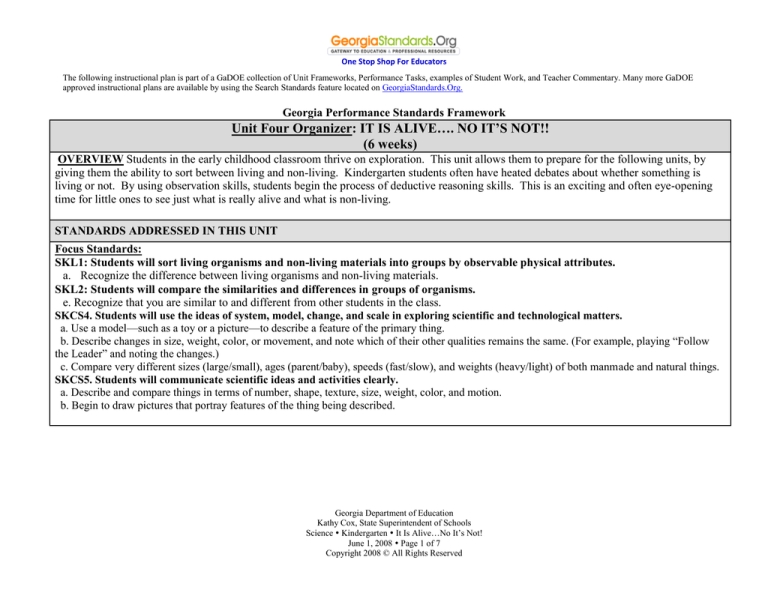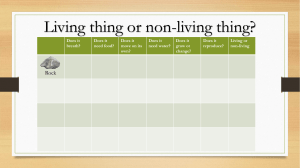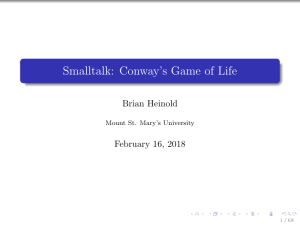Framework - It Is Alive...No It`s Not
Anuncio

One Stop Shop For Educators The following instructional plan is part of a GaDOE collection of Unit Frameworks, Performance Tasks, examples of Student Work, and Teacher Commentary. Many more GaDOE approved instructional plans are available by using the Search Standards feature located on GeorgiaStandards.Org. Georgia Performance Standards Framework Unit Four Organizer: IT IS ALIVE…. NO IT’S NOT!! (6 weeks) OVERVIEW Students in the early childhood classroom thrive on exploration. This unit allows them to prepare for the following units, by giving them the ability to sort between living and non-living. Kindergarten students often have heated debates about whether something is living or not. By using observation skills, students begin the process of deductive reasoning skills. This is an exciting and often eye-opening time for little ones to see just what is really alive and what is non-living. STANDARDS ADDRESSED IN THIS UNIT Focus Standards: SKL1: Students will sort living organisms and non-living materials into groups by observable physical attributes. a. Recognize the difference between living organisms and non-living materials. SKL2: Students will compare the similarities and differences in groups of organisms. e. Recognize that you are similar to and different from other students in the class. SKCS4. Students will use the ideas of system, model, change, and scale in exploring scientific and technological matters. a. Use a model—such as a toy or a picture—to describe a feature of the primary thing. b. Describe changes in size, weight, color, or movement, and note which of their other qualities remains the same. (For example, playing “Follow the Leader” and noting the changes.) c. Compare very different sizes (large/small), ages (parent/baby), speeds (fast/slow), and weights (heavy/light) of both manmade and natural things. SKCS5. Students will communicate scientific ideas and activities clearly. a. Describe and compare things in terms of number, shape, texture, size, weight, color, and motion. b. Begin to draw pictures that portray features of the thing being described. Georgia Department of Education Kathy Cox, State Superintendent of Schools Science Kindergarten It Is Alive…No It‟s Not! June 1, 2008 Page 1 of 7 Copyright 2008 © All Rights Reserved One Stop Shop For Educators STANDARDS ADDRESSED IN THIS UNIT Supporting Standards: ELAKR1. The student demonstrates knowledge of concepts of print. The student: a. Recognizes that print and pictures can inform, entertain, and persuade. b. Demonstrates that print has meaning and represents spoken language in written form. ELAKR5. The student acquires and uses grade-level words to communicate effectively. The student a. Listens to a variety of texts and uses new vocabulary in oral language. ELAKR6. The student gains meaning from orally presented text. The student a. Listens to a variety of literary and informational texts and materials to gain knowledge and for pleasure. ELAKW1. The students begin to understand the principle of writing. LITERATURE SELECTIONS: Source of Recommendation NSTA Recommends NSTA Recommends Children‟s Bookpage Parents Magazine‟s Best Books List Title Life on Ice Animal Life Cycles Jubal‟s Wish Little Beaver and the Echo Author Susan Goodman Bobbie Kalman Audrey Wood Amy MacDondald ENDURING UNDERSTANDINGS Everything can be classified as living or non-living. Living things have certain observable attributes. Non-living things have certain observable attributes. ESSENTIAL QUESTIONS: How do you know something is living? How do you know something is non-living? What does a living thing need to „live‟? How are living and non-living things different? Georgia Department of Education Kathy Cox, State Superintendent of Schools Science Kindergarten It Is Alive…No It‟s Not! June 1, 2008 Page 2 of 7 Copyright 2008 © All Rights Reserved ISBN 0761327754 0778723127 043916964X 0-698-11628-3 One Stop Shop For Educators MISCONCEPTIONS PROPER CONCEPTIONS Dinosaurs are non-living. Seeds are not living, until they are given nutrients and energy. Everything in nature is alive. CONCEPTS: Students will be able to distinguish between living and non-living. KNOW AND DO Students will be able to look for both similarities and differences in living and non-living materials. Students will be able to sort living organisms and non-living materials. Living things have basic needs that are needed to keep them alive, such as food and water. Students will be able to identify what living things need in order to survive/live. Students will also be able to identify why nonliving materials are not „living‟. Some plants and animals that were living are now extinct. A living thing such as a seed or a pupa can appear dormant but still be considered “living”. Some things found in nature -like rocks - are never living. LANGUAGE Alike Living Non-Living Different Similar Georgia Department of Education Kathy Cox, State Superintendent of Schools Science Kindergarten It Is Alive…No It‟s Not! June 1, 2008 Page 3 of 7 Copyright 2008 © All Rights Reserved EVIDENCE OF LEARNING Drawings, Charts, Tables, Graphs and Science Journal Entries may all be used for evidence of learning. One Stop Shop For Educators GRASP Culminating Activity: The ROAMING Reporter GRASPS Goal: Students will choose and create slide shows (with teachers assistance) to present to the class as a reporter. The student will have to provide self chosen objects and reasoning behind each chosen item. Role: Each student will be a reporter for the evening news. They may dress up and the teacher may want to provide a microphone.\] Audience: Other classroom students, administration, parents, invited guests, possibly entire school. Scenario: Each student will be responsible for choosing two items. One living and one non-living. They, with teachers help, may take a digital picture of each item and then using a web graphic organizer, give details of why it is living or non-living. The teacher will then place the pictures and scanned graphic organizers into a slide show format (whatever software is available at each school) The teacher will then have the student present their „segments‟ of reporting, and it may be videotaped to air to the school on closed circuit television as a complete news program. Product: A Video Presentation of each smaller segment of news reporting of living and non-living things. With students presenting their work and giving evidence for each item. Georgia Department of Education Kathy Cox, State Superintendent of Schools Science Kindergarten It Is Alive…No It‟s Not! June 1, 2008 Page 4 of 7 Copyright 2008 © All Rights Reserved One Stop Shop For Educators TASK Lesson Title: From The ANYthing Box Essential Question: How can you tell if things are living or non living? Teacher Instructions: Teacher will read one of the suggested books about living things. Students will then be asked to pick someone to choose something out of the ANYthing box. (This is a medium to large box that has a number of things in it, from pictures of animals to rocks, anything that can be living and non living.) Each day before the science lessons students choose something out of the box and discuss its attributes that make it either living or non-living. Also, items can be graphed to incorporate a math connection. Enrichment/Extension/Homework: Have students bring in things secretly to put into the anything box. TASK Lesson Title: My home is where I live Essential Question: What do living things need to live? Teacher Instructions: Teacher will ask students to describe characteristics and needs of living organisms and non living materials. Students will also be asked what plants need to grow and survive. This will be labeled on the picture as well. The teacher then reads the book: A House for Hermit Crab by Eric Carle. In this book the teacher explains how the shell (non living) and the hermit crab (living) need each other. There are other examples in the book of living and non living things for students to make connections. Have students talk about living and non living things and how they coexist. You may bring in a picture of your own home and a picture of yourself outside. Talk about how you are living and the house is non living. Give students a piece of paper folded in half horizontal (hamburger). On one side have the students draw themselves, their family, pets, etc and on the other have them draw their house and things around it (cars, plants, etc.) Assessment: Give students time to complete task and verbally assess if they can point out differences in themselves and their home (living organisms and non-living materials) Have students label each item in their pictures with “L” for living and “NL” for non living. Enrichment/Extension/Homework: Allow students to take pictures at home and bring them in and point out differences during a share time before the science lesson. Georgia Department of Education Kathy Cox, State Superintendent of Schools Science Kindergarten It Is Alive…No It‟s Not! June 1, 2008 Page 5 of 7 Copyright 2008 © All Rights Reserved One Stop Shop For Educators TASK Lesson Title: Sort and Stack Essential Question: What is living? What is non-living? Teacher Instructions: Students are given a bag with picture cards inside. These cards of several different item both living and non living. (These cards can be printed from clipart and the Internet, magazine pictures, etc) Have a tray or sentence strip holder labeled 1 side LIVING and the other side NON-LIVING. Have students begin to sort their cards into the two categories. Then have them place them into the appropriate stack. Students can then take their card /picture stacks and place them into the „group‟ Venn Diagram (2 hoola hoops) Have students begin to dialogue about similarities and differences. The middle (both) of the VD might prove interesting as students can begin to question things like wood logs, or pieces of wood (things that were living) You may want to have a large drawn or printed Venn Diagram for students to label or paste their cards. Assessment: Check for understanding through questions about the students sorting. Also, question the Venn Diagrams and stimulate dialogue between students. Enrichment/Extension/Homework: Have students bring in pictures to place in the class Venn Diagram. TEACHER RESOURCES Additional Children’s Literature: Plantzilla, Jeraldine Nolen 0-15202412-3 Benjamin McFadden and the Robot Babysitter, Timothy Bush Ding Dong Ding Dong, Margie Palatini I‟m Alive: I can Move, Mandy Suhr (from GYSTC Inc. lessons) What is a Living Thing? Bobbie Kalman (from GYSTC Inc. lessons) When Agnes Caws, Candace Fleming Chickens Aren‟t the Only Ones, Ruth Heller Web Resources: http://www.amymacdonald.com/activity-echo.html (Teaching suggestions for Little Beaver & the Echo) http://www.amnh.org/ology/index.php?channel=biodiversity Georgia Department of Education Kathy Cox, State Superintendent of Schools Science Kindergarten It Is Alive…No It‟s Not! June 1, 2008 Page 6 of 7 Copyright 2008 © All Rights Reserved One Stop Shop For Educators Additional Teacher Resources: *Integrating Science and Literacy Instruction: A Framework for Bridging the Gap, Gene Freeman and Vickie Taylor: ISBN 1-578-86403-8 Georgia Department of Education Kathy Cox, State Superintendent of Schools Science Kindergarten It Is Alive…No It‟s Not! June 1, 2008 Page 7 of 7 Copyright 2008 © All Rights Reserved


